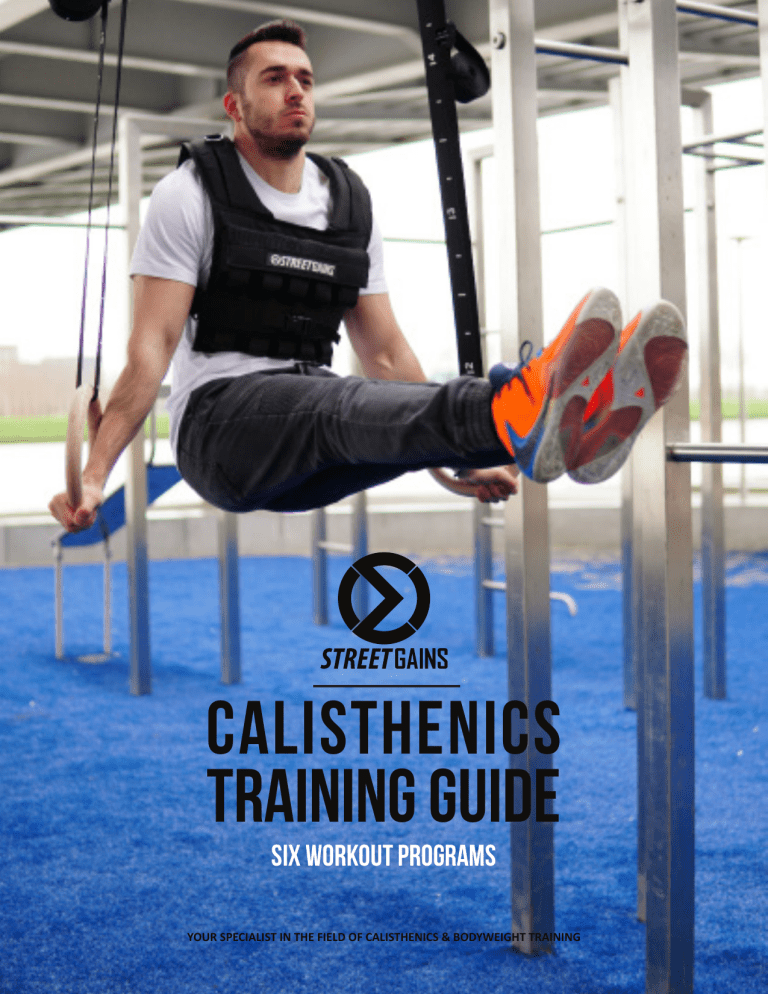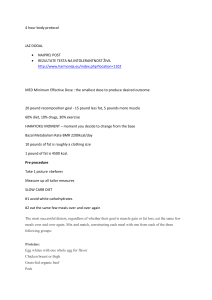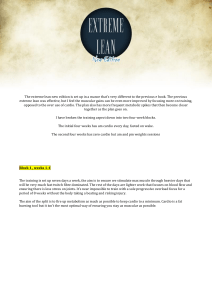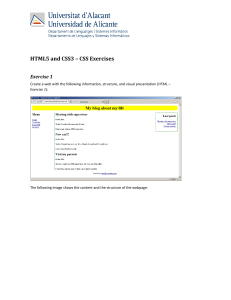
CALISTHENICS TRAINING GUIDE SIX WORKOUT PROGRAMS YOUR SPECIALIST IN THE FIELD OF CALISTHENICS & BODYWEIGHT TRAINING Table of contents INTRODUCTION CALISTHENICS WORKOUT PROGRAMS FOR BEGINNERS Beginner workout program 3-days Beginner workout program 4-days CALISTHENICS WORKOUT PROGRAMS FOR INTERMEDIATE Intermediate workout program 3-days Intermediate worrkout program 4-days CALISTHENICS WORKOUT PROGRAM FOR ADVANCED Advanced workout program 3-days Advanced workout program 4-days INTRODUCTION “Calistenics Training Guide: Six Workout Programs” Welcome to “Calistenics Training Guide: Six Workout Programs”! This guide is your gateway to unlocking the immense potential of calisthenics, a form of exercise that utilizes your body’s own weight to build strength, flexibility, and endurance. Whether you’re a beginner just starting your fitness journey or an experienced enthusiast looking to take your calisthenics practice to new heights, this guide will provide you with carefully designed workout programs to help you achieve your goals. Calisthenics, also known as bodyweight training, offers a unique approach to fitness that can be tailored to suit individuals of all fitness levels. It combines elements of strength training, gymnastics, and functional movements to create a well-rounded and effective workout regimen. By harnessing the power of gravity and incorporating equipment such as resistance bands, gymnastic rings, a weight vest and parallettes, you can build strength, improve mobility, and develop impressive body control. In this guide, we have crafted a series of workout programs designed to cater to different skill levels and goals. Whether you’re looking to increase strength, build muscle, improve flexibility, or enhance overall athleticism, our programs will guide you through a structured and progressive journey that optimizes your results. Let’s embark on this journey together and revolutionize your fitness through the incredible world of calisthenics! Remember to warm up before each workout and cool down/stretch afterwards. If you have any existing injuries or health conditions, please consult with a professional before attempting this or any other exercise program. CALISTHENICS WORKOUT PROGRAMS FOR BEGINNERS Beginner workout program 3-days Day 1: Full Body • • • • • Push-Ups: 3 sets of 8-10 reps Bodyweight Squats (using mini bands): 3 sets of 10-12 reps Assisted Pull-Ups (using resistance bands): 3 sets of 8-10 reps Dips (using parallettes or a sturdy chair): 3 sets of 8-10 reps Plank: 3 sets of 30-45 seconds Day 2: Lower Body Focus • • • • • Lunges: 3 sets of 10-12 reps each leg Glute Bridges (using mini bands): 3 sets of 10-12 reps Step-Ups: 3 sets of 10-12 reps each leg Calf Raises: 3 sets of 10-12 reps Mountain Climbers: 3 sets of 10-12 reps per leg Day 3: Upper Body Focus • • • • • Incline Push-Ups (using parallettes or an elevated surface): 3 sets of 8-10 reps Bodyweight Rows (using a suspension trainer or gymnastic rings: 3 sets of 8-10 reps Assisted Dips (using resistance bands and dip bars): 3 sets of 8-10 reps Plank Shoulder Taps: 3 sets of 8-10 reps per side Reverse Snow Angels: 3 sets of 10-12 reps Additional Guidelines: 1. 2. 3. 4. 5. 6. 7. Rest: Take 60-90 seconds of rest between sets. Progression: As you get stronger, gradually increase the number of repetitions or sets. You can also progress to more challenging variations of the exercises (e.g., incline push-ups to standard push-ups, assisted pull-ups to unassisted pull-ups). Form and Technique: Focus on maintaining proper form throughout each exercise. It’s better to perform fewer reps with good form than to sacrifice form for higher numbers. Range of Motion: Aim to perform exercises through a full range of motion, ensuring that you feel a stretch and contraction in the target muscles. Listen to your body: If an exercise feels too challenging or causes pain, modify it or seek alternatives that are suitable for your current fitness level. Gradual Increases: Gradually increase the intensity and difficulty of your workouts over time to avoid overexertion and allow your body to adapt. Cardiovascular Exercise: Consider incorporating cardiovascular activities such as brisk walking, jogging, or cycling on your non-workout days to improve cardiovascular fitness. Beginner workout program 4-days Day 1: Full Body • • • • • Push-Ups: 3 sets of 8-10 reps Bodyweight Squats (using mini bands): 3 sets of 10-12 reps Assisted Pull-Ups (using resistance bands): 3 sets of 8-10 reps Dips (using parallettes or a sturdy chair): 3 sets of 8-10 reps Plank: 3 sets of 30-45 seconds Day 2: Lower Body Focus • • • • • Lunges: 3 sets of 10-12 reps each leg Glute Bridges (using mini bands): 3 sets of 10-12 reps Step-Ups: 3 sets of 10-12 reps each leg Calf Raises: 3 sets of 10-12 reps Mountain Climbers: 3 sets of 10-12 reps per leg Day 3: Upper Body Focus • • • • • Incline Push-Ups (using parallettes or an elevated surface): 3 sets of 8-10 reps Bodyweight Rows (using a suspension trainer or gymnastic rings): 3 sets of 8-10 reps Assisted Dips (using resistance bands and dip bars): 3 sets of 8-10 reps Plank Shoulder Taps: 3 sets of 8-10 reps per side Reverse Snow Angels: 3 sets of 10-12 reps Day 4: Full Body (Variation) • • • • • Squat Jumps: 3 sets of 8-10 reps Push-Ups with Shoulder Taps: 3 sets of 8-10 reps Assisted Chin-Ups (using resistance bands): 3 sets of 8-10 reps Bulgarian Split Squats: 3 sets of 8-10 reps each leg Plank to Downward Dog: 3 sets of 8-10 reps Additional Guidelines: 1. 2. 3. 4. 5. 6. 7. Rest: Take 60-90 seconds of rest between sets. Progression: As you get stronger, gradually increase the number of repetitions or sets. You can also progress to more challenging variations of the exercises (e.g., incline push-ups to standard push-ups, assisted pull-ups to unassisted pull-ups). Form and Technique: Focus on maintaining proper form throughout each exercise. It’s better to perform fewer reps with good form than to sacrifice form for higher numbers. Range of Motion: Aim to perform exercises through a full range of motion, ensuring that you feel a stretch and contraction in the target muscles. Listen to your body: If an exercise feels too challenging or causes pain, modify it or seek alternatives that are suitable for your current fitness level. Gradual Increases: Gradually increase the intensity and difficulty of your workouts over time to avoid overexertion and allow your body to adapt. Cardiovascular Exercise: Consider incorporating cardiovascular activities such as brisk walking, jogging, or cycling on your non-workout days to improve cardiovascular fitness. CALISTHENICS WORKOUT PROGRAMS FOR INTERMeDIATE Intermediate workout program 3-days Day 1: Full Body Strength • • • • • • Resistance Band Push-Ups: 3 sets of 8-10 reps Ring Rows: 3 sets of 8-10 reps Bulgarian Split Squats with Resistance Band: 3 sets of 8-10 reps each leg Pike Push-Ups on Parallettes: 3 sets of 8-10 reps Australian Pull-Ups with Suspension Trainer: 3 sets of 8-10 reps Plank: 3 sets of 30-45 seconds Day 2: Upper Body Skill and Conditioning • • • • • • Diamond Push-Ups with Push-Up Bars: 3 sets of 6-8 reps Ring Muscle-Ups: 3 sets of 5-7 reps Handstand Practice on Parallettes: 3 sets of 30-60 seconds Dips with Ankle Weights: 3 sets of 8-10 reps Hanging Leg Raises with Gymnastic Rings: 3 sets of 8-10 reps Russian Twists with Ankle Weights: 3 sets of 12-15 reps per side Day 3: Lower Body Skill and Conditioning • • • • • • Pistol Squats: 3 sets of 6-8 reps each leg Glute Bridges with Mini Bands: 3 sets of 8-10 reps Box Jumps with Ankle Weights: 3 sets of 8-10 reps Calf Raises with Ankle Weights: 3 sets of 12-15 reps Side Lunges with Mini Bands: 3 sets of 8-10 reps each leg L-Sit Hold on Parallettes: 3 sets of 20-30 seconds Additional Guidelines: 1. 2. Rest: Take 60-90 seconds of rest between sets. Progression:As you get stronger, gradually increase the resistance, difficulty, or intensity of the exercises. You can use thicker resistance bands, increase the weight, or progress to more advanced variations. 3. Form and Technique: Focus on maintaining proper form throughout each exercise. Prioritize quality over quantity. 4. Range of Motion: Aim to perform exercises through a full range of motion, ensuring that you feel a stretch and contraction in the target muscles. 5. Skill Work: Dedicate time to practicing advanced skills such as handstands and ring work. 6. Mobility and Flexibility: Incorporate mobility exercises and stretches to improve joint range of motion and prevent injuries. 7. Listen to your body: If an exercise feels too challenging or causes pain, modify it or seek alternatives that are suitable for your current fitness level. 8. Warm-up and Cool-down: Prioritize a proper warm-up and cool-down routine to prepare your body for the workout and aid in recovery. 9. Gradual Increases: Gradually increase the intensity and difficulty of your workouts over time to avoid overexertion and allow your body to adapt. 10. Equipment Usage: Incorporate resistance bands, gymnastic rings, parallettes, ankle weights or a weight vest as indicated in the exercises. Adjust the resistance or weight as needed to challenge yourself appropriately. 11. Rest and Recovery: Allow your body enough time to rest and recover between workouts. Schedule rest days between training days to prevent overtraining and promote proper recovery. 12. Stay dedicated, motivated, and enjoy the process of improving your strength and skills through calisthenics training. 13. Consistency and Progress Tracking: Stay consistent with your workouts and track your progress over time. Keep a workout log or use a fitness tracking app to monitor your improvements, such as increasing the number of reps, sets, or difficulty levels. Intermediate workout program 4-days Day 1: Upper Body Strength • • • • • • Resistance Band Push-Ups: 3 sets of 8-10 reps Ring Rows: 3 sets of 8-10 reps Pike Push-Ups on Parallettes: 3 sets of 8-10 reps Ring Dips: 3 sets of 8-10 reps Australian Pull-Ups with Suspension Trainer: 3 sets of 8-10 reps Plank: 3 sets of 30-45 seconds Day 2: Lower Body Strength • • • • • • Bulgarian Split Squats with Resistance Band: 3 sets of 8-10 reps each leg Glute Bridges with Mini Bands: 3 sets of 8-10 reps Pistol Squats: 3 sets of 8-10 reps each leg Calf Raises with Ankle Weights: 3 sets of 12-15 reps Side Lunges with Mini Bands: 3 sets of 8-10 reps each leg L-Sit Hold on Parallettes: 3 sets of 20-30 seconds Day 3: Upper Body Skill and Conditioning • • • • • • Archer Push-Ups: 3 sets of 6-8 reps each arm Ring Muscle-Ups: 3 sets of 5-7 reps Handstand Practice on Parallettes: 3 sets of 30-60 seconds Ring Dips: 3 sets of 8-10 reps with ankle weights Hanging Leg Raises with Gymnastic Rings: 3 sets of 8-10 reps Russian Twists with Ankle Weights: 3 sets of 12-15 reps per side Day 4: Lower Body Skill and Conditioning • • • • • • Box Jumps with Ankle Weights: 3 sets of 8-10 reps Tuck Jumps: 3 sets of 8-10 reps Bulgarian Split Squats with Rear Foot Elevated and Resistance Band: 3 sets of 8-10 reps each leg Pistol Squat Negatives: 3 sets of 6-8 reps each leg Plank to Push-Up: 3 sets of 8-10 reps Bicycle Crunches with Ankle Weights: 3 sets of 12-15 reps per side Additional Guidelines: 1. 2. Rest: Take 60-90 seconds of rest between sets. Progression:As you get stronger, gradually increase the resistance, difficulty, or intensity of the exercises. You can use thicker resistance bands, increase the weight, or progress to more advanced variations. 3. Form and Technique: Focus on maintaining proper form throughout each exercise. Prioritize quality over quantity. 4. Range of Motion: Aim to perform exercises through a full range of motion, ensuring that you feel a stretch and contraction in the target muscles. 5. Skill Work: Dedicate time to practicing advanced skills such as handstands and ring work. 6. Mobility and Flexibility: Incorporate mobility exercises and stretches to improve joint range of motion and prevent injuries. 7. Listen to your body: If an exercise feels too challenging or causes pain, modify it or seek alternatives that are suitable for your current fitness level. 8. Warm-up and Cool-down: Prioritize a proper warm-up and cool-down routine to prepare your body for the workout and aid in recovery. 9. Gradual Increases: Gradually increase the intensity and difficulty of your workouts over time to avoid overexertion and allow your body to adapt. 10. Equipment Usage: Incorporate resistance bands, gymnastic rings, parallettes, ankle weights or a weight vest as indicated in the exercises. Adjust the resistance or weight as needed to challenge yourself appropriately. 11. Rest and Recovery: Allow your body enough time to rest and recover between workouts. Schedule rest days between training days to prevent overtraining and promote proper recovery. 12. Stay dedicated, motivated, and enjoy the process of improving your strength and skills through calisthenics training. CALISTHENICS WORKOUT PROGRAMS FOR advanced Advanced workout program 3-days Day 1: Upper Body Focus • • • • • • Handstand Push-Ups: 3 sets of 8-10 reps One-Arm Push-Ups: 3 sets of 6-8 reps each arm Weighted Ring Muscle-Ups: 3 sets of 5-7 reps (with weight vest) Archer Pull-Ups: 3 sets of 8-10 reps each arm Ring Dips: 3 sets of 8-10 reps (with weight vest) L-Sit Hold on Rings: 3 sets of 20-30 seconds Day 2: Lower Body Focus • • • • • • Pistol Squats: 3 sets of 6-8 reps each leg Shrimp Squats: 3 sets of 6-8 reps each leg (with weight vest) Nordic Curls: 3 sets of 8-10 reps Weighted Box Jumps: 3 sets of 8-10 reps (with weight vest) Single-Leg Romanian Deadlifts: 3 sets of 8-10 reps each leg (with resistance bands) Plank with Resistance Band: 3 sets of 60 seconds Day 3: Full Body • • • • • • Planche Push-Ups: 3 sets of 6-8 reps Front Lever Rows: 3 sets of 6-8 reps Handstand Push-Ups on Rings: 3 sets of 8-10 reps Dragon Flags: 3 sets of 6-8 reps (with ankle weights) Weighted Muscle-Up: 3 sets of 5-7 reps (with weight vest) Hollow Body Hold with Resistance Band: 3 sets of 30-60 seconds Additional Guidelines: 1. 2. 3. 4. 5. 6. 7. 8. 9. Rest: Take 90-150 seconds of rest between sets for compound exercises and 30-60 seconds for isolation exercises. Progressive Overload: Gradually increase the weight, resistance band tension, or difficulty of exercises as you get stronger to continue making progress. Skill Work: Allocate time for practicing advanced skills like freestanding handstands, ring muscle-ups, and more. Mobility and Flexibility: Incorporate mobility exercises and stretches to improve joint range of motion and prevent injuries. Consistency and Progress Tracking: Stay consistent with your workouts and track your progress over time. Keep a workout log or use a fitness tracking app to monitor your improvements, such as increasing the number of reps, sets, or difficulty levels. Weight Vest: Incorporate a weight vest to increase the intensity of exercises like one-arm push-ups, muscle-ups, planche push-ups, front lever rows, and weighted dips. Start with a weight that challenges you but allows you to maintain proper form. Rings: Use gymnastic rings for exercises such as ring muscle-ups, ring dips, and ring push-ups. They provide an additional challenge to your stability and engage more muscles for improved strength and control. Resistance Bands: Integrate resistance bands into exercises like single-leg Romanian deadlifts and hollow body holds to add accommodating resistance and challenge different parts of the movement. Safety: Pay careful attention to proper form and technique, especially when incorporating weighted exercises. Maintain control throughout the range of motion and avoid sacrificing form for heavier weights. Advanced workout program 4-days Day 1: Upper Body Strength • • • • • • Weighted Ring Muscle-Ups: 4 sets of 5-7 reps (with weight vest) One-Arm Push-Ups: 4 sets of 6-8 reps each arm Archer Pull-Ups: 4 sets of 8-10 reps each arm Weighted Ring Dips: 4 sets of 8-10 reps (with weight vest) Handstand Push-Ups: 4 sets of 8-10 reps L-Sit Hold on Rings: 4 sets of 20-30 seconds Day 2: Lower Body Strength • • • • • • Shrimp Squats: 4 sets of 6-8 reps each leg (with weight vest) Single-Leg Romanian Deadlifts: 4 sets of 8-10 reps each leg (with resistance bands) Nordic Curls: 4 sets of 8-10 reps Weighted Box Jumps: 4 sets of 8-10 reps (with weight vest) Pistol Squats: 4 sets of 6-8 reps each leg Plank with Resistance Band: 4 sets of 60 seconds Day 3: Upper Body Skill and Conditioning • • • • • • Freestanding Handstand Practice: 15 minutes Ring Muscle-Ups: 4 sets of 5-7 reps Push-Up Variations (e.g., Archer Push-Ups, Pseudo Planche Push-Ups): 4 sets of 8-10 reps Pull-Up Variations (e.g., L-Sit Pull-Ups, Wide-Grip Pull-Ups): 4 sets of 8-10 reps Dips: 4 sets of 8-10 reps Core exercises (e.g., Dragon Flags, Hollow Body Holds): 4 sets of 6-8 reps or 20-30 seconds Day 4: Lower Body Skill and Conditioning • • • • • • Lunge Variations (e.g., Walking Lunges, Bulgarian Split Squats): 4 sets of 8-10 reps each leg Pistol Squats: 4 sets of 6-8 reps each leg Glute Bridges with Resistance Band: 4 sets of 8-10 reps Box Jumps: 4 sets of 8-10 reps Plyometric exercises (e.g., Tuck Jumps, Jumping Lunges): 4 sets of 8-10 reps Core exercises (e.g., V-Ups, Russian Twists): 4 sets of 8-10 reps Additional Guidelines: 1. 2. 3. 4. 5. 6. 7. 8. 9. Rest: Take 90-150 seconds of rest between sets for compound exercises and 30-60 seconds for isolation exercises. Progressive Overload: Gradually increase the weight, resistance band tension, or difficulty of exercises as you get stronger to continue making progress. Skill Work: Allocate time for practicing advanced skills like freestanding handstands, ring muscle-ups, and more. Mobility and Flexibility: Incorporate mobility exercises and stretches to improve joint range of motion and prevent injuries. Consistency and Progress Tracking: Stay consistent with your workouts and track your progress over time. Keep a workout log or use a fitness tracking app to monitor your improvements, such as increasing the number of reps, sets, or difficulty levels. Weight Vest: Incorporate a weight vest to increase the intensity of exercises like one-arm push-ups, muscle-ups, planche push-ups, front lever rows, and weighted dips. Start with a weight that challenges you but allows you to maintain proper form. Rings: Use gymnastic rings for exercises such as ring muscle-ups, ring dips, and ring push-ups. They provide an additional challenge to your stability and engage more muscles for improved strength and control. Resistance Bands: Integrate resistance bands into exercises like single-leg Romanian deadlifts and hollow body holds to add accommodating resistance and challenge different parts of the movement. Safety: Pay careful attention to proper form and technique, especially when incorporating weighted exercises. Maintain control throughout the range of motion and avoid sacrificing form for heavier weights.





